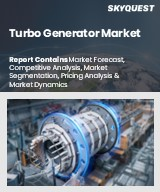
|
시장보고서
상품코드
1777311
터보 제너레이터 시장 규모, 점유율, 성장 분석 : 유형별, 냉각 시스템별, 최종사용자별, 지역별 - 산업 예측(2025-2032년)Turbo Generator Market Size, Share, and Growth Analysis, By Type (Gas Turbine Generator, Steam Turbine Generator), By Cooling System (Air Cooled, Water Cooled), By End User, By Region - Industry Forecast 2025-2032 |
||||||
세계의 터보 제너레이터 시장 규모는 2023년에 115억 달러로 평가되며, 예측 기간(2025-2032년)의 CAGR은 5.3%로 성장하며, 2024년 121억 1,000만 달러에서 2032년에는 183억 달러로 성장할 전망입니다.
세계 터보 발전기 시장은 첨단 발전 기술의 채택이 증가함에 따라 성장하고 있습니다. 각국은 기저 및 피크시 전력 수요에 대응하는 동시에 배출 기준을 준수하기 위해 기존 석탄 기반 시스템에서 가스 및 하이브리드 플랜트로의 전환을 추진하고 있습니다. 저용량, 모듈형, 공랭식 시스템에 대한 수요는 산업화와 인프라 성장으로 인해 아시아태평양 및 중동에서 특히 증가하고 있습니다. 특히 보다 효율적인 터보 발전기를 통한 기존 플랜트 개조가 신규 설비 용량에 크게 기여하고 있습니다. 새로운 시장 동향으로는 클린 에너지 및 하이브리드 솔루션으로의 광범위한 전환을 반영하는 수소혼소, AI 기반 진단, 예지보전 등을 들 수 있습니다. 그러나 신흥 시장에서는 높은 초기 설비투자와 숙련된 노동력 부족이 여전히 중요한 과제로 남아있습니다.
목차
서론
- 조사의 목적
- 조사 범위
- 정의
조사 방법
- 정보 조달
- 2차와 1차 데이터 방법
- 시장 규모 예측
- 시장의 전제조건과 제한
개요
- 세계 시장 전망
- 공급과 수요 동향 분석
- 부문별 기회 분석
시장 역학과 전망
- 시장 개요
- 시장 규모
- 시장 역학
- 촉진요인과 기회
- 억제요인과 과제
- Porter의 산업 분석
주요 시장 인사이트
- 주요 성공 요인
- 경쟁의 정도
- 주요 투자 기회
- 시장 에코시스템
- 시장의 매력 지수(2024년)
- PESTEL 분석
- 거시경제 지표
- 밸류체인 분석
- 가격 분석
- 특허 분석
- 규제 분석
- 기술 분석
- 사례 연구
- 고객 구매 행동 분석
터보 제너레이터 시장 규모 : 유형별 & CAGR(2025-2032)
- 시장 개요
- 가스 터빈 발전기
- 증기 터빈 발전기
- 수력 터빈 발전기
터보 제너레이터 시장 규모 : 냉각 시스템별 & CAGR(2025-2032)
- 시장 개요
- 공랭식
- 수랭식
- 수소 냉각
터보 제너레이터 시장 규모 : 최종사용자별 & CAGR(2025-2032)
- 시장 개요
- 석탄 화력발전소
- 원자력발전소
- 가스 발전소
- 기타
터보 제너레이터 시장 규모 : 지역별 & CAGR(2025-2032)
- 북미
- 미국
- 캐나다
- 유럽
- 독일
- 스페인
- 프랑스
- 영국
- 이탈리아
- 기타 유럽 지역
- 아시아태평양
- 중국
- 인도
- 일본
- 한국
- 기타 아시아태평양
- 라틴아메리카
- 브라질
- 기타 라틴아메리카 지역
- 중동 및 아프리카
- GCC 국가
- 남아프리카공화국
- 기타 중동 및 아프리카
경쟁 정보
- 상위 5사의 비교
- 주요 기업의 시장 포지셔닝(2024년)
- 주요 시장 기업이 채택한 전략
- 최근 시장 동향
- 기업의 시장 점유율 분석(2024년)
- 주요 기업의 기업 개요
- 기업의 상세
- 제품 포트폴리오 분석
- 기업의 부문별 점유율 분석
- 매출의 전년대비 비교(2022-2024년)
주요 기업 개요
- Harbin Electric Co., Ltd.
- GE Power(GE Vernova)
- Toshiba Energy Systems & Solutions Corporation
- Shanghai Electric Group Co., Ltd.
- Doosan Enerbility Co., Ltd.
- Siemens Energy AG
- Mitsubishi Power(Mitsubishi Hitachi Power Systems, Ltd.)
- Bharat Heavy Electricals Limited
- Fuji Electric Co., Ltd.
- Dongfang Electric Corporation
결론과 제안
KSA 25.08.01Global Turbo Generator Market size was valued at USD 11.5 billion in 2023 and is poised to grow from USD 12.11 billion in 2024 to USD 18.3 billion by 2032, growing at a CAGR of 5.3% during the forecast period (2025-2032).
The global turbo generator market is experiencing growth driven by increased adoption of advanced power generation technologies. Nations are transitioning from traditional coal-based systems to gas and hybrid plants to comply with emission standards while addressing both baseload and peak power demands. The demand for low-capacity, modular, and air-cooled systems is particularly rising in the Asia-Pacific and Middle East regions due to industrialization and infrastructure growth. Notably, retrofitting existing plants with more efficient turbo generators is contributing significantly to new capacities. Emerging market trends include hydrogen co-firing, AI-based diagnostics, and predictive maintenance, reflecting a broader shift toward clean energy and hybrid solutions. However, high initial capital investment and a shortage of skilled labor remain critical challenges in developing markets.
Top-down and bottom-up approaches were used to estimate and validate the size of the Global Turbo Generator market and to estimate the size of various other dependent submarkets. The research methodology used to estimate the market size includes the following details: The key players in the market were identified through secondary research, and their market shares in the respective regions were determined through primary and secondary research. This entire procedure includes the study of the annual and financial reports of the top market players and extensive interviews for key insights from industry leaders such as CEOs, VPs, directors, and marketing executives. All percentage shares split, and breakdowns were determined using secondary sources and verified through Primary sources. All possible parameters that affect the markets covered in this research study have been accounted for, viewed in extensive detail, verified through primary research, and analyzed to get the final quantitative and qualitative data.
Global Turbo Generator Market Segments Analysis
Global Turbo Generator Market is segmented by Type, Cooling System, End User and region. Based on Type, the market is segmented into Gas Turbine Generator, Steam Turbine Generator and Water Turbine Generator. Based on Cooling System, the market is segmented into Air Cooled, Water Cooled and Hydrogen Cooled. Based on End User, the market is segmented into Coal Power Plants, Nuclear Power Plants, Gas Power Plants and Others. Based on region, the market is segmented into North America, Europe, Asia Pacific, Latin America and Middle East & Africa.
Driver of the Global Turbo Generator Market
The Global Turbo Generator market is experiencing significant growth driven by rising investments from governments and utility companies in modular power solutions, particularly in industrial sectors and remote locations. Innovations in turbo generator technology have resulted in efficient, compact configurations that offer plug-and-play capabilities, making them ideal for emergency situations and off-grid power applications. For instance, the adoption of skid-mounted turbo generators enhances the reliability of microgrids in mining areas, while mobile power units cater to regions vulnerable to flooding. This demand for versatile and reliable power sources is shaping the future landscape of the turbo generator market.
Restraints in the Global Turbo Generator Market
The Global Turbo Generator market faces significant challenges due to the high installation costs, which can range from US$5 million to US$10 million per megawatt. In emerging economies, particularly in regions like Southeast Asia, project delays often arise because the costs associated with commissioning turbo generators exceed the financial capacities of these local markets. This capital-intensive nature of the technology restricts its widespread adoption, even though it may offer cost-effective performance over time. As a result, potential advancements and the overall growth of the market are being hindered by financial constraints and the inability to meet initial investment requirements.
Market Trends of the Global Turbo Generator Market
The Global Turbo Generator market is witnessing a notable shift towards air-cooled generators, driven by their suitability for modular and decentralized power plant applications, particularly in the Asia-Pacific and Middle East regions. These generators are increasingly preferred due to their compact design, ease of installation, and minimized cooling infrastructure requirements, making them ideal for space-limited environments. In 2024, Siemens Energy expanded its range of air-cooled turbines specifically for off-grid uses, such as remote industrial clusters and mines in Southeast Asia. This trend highlights an emerging demand for plug-and-play installations, enabling rapid deployment of skid-mounted units for both standby and temporary power solutions.
Table of Contents
Introduction
- Objectives of the Study
- Scope of the Report
- Definitions
Research Methodology
- Information Procurement
- Secondary & Primary Data Methods
- Market Size Estimation
- Market Assumptions & Limitations
Executive Summary
- Global Market Outlook
- Supply & Demand Trend Analysis
- Segmental Opportunity Analysis
Market Dynamics & Outlook
- Market Overview
- Market Size
- Market Dynamics
- Drivers & Opportunities
- Restraints & Challenges
- Porters Analysis
- Competitive rivalry
- Threat of substitute
- Bargaining power of buyers
- Threat of new entrants
- Bargaining power of suppliers
Key Market Insights
- Key Success Factors
- Degree of Competition
- Top Investment Pockets
- Market Ecosystem
- Market Attractiveness Index, 2024
- PESTEL Analysis
- Macro-Economic Indicators
- Value Chain Analysis
- Pricing Analysis
- Patent Analysis
- Regulatory Analysis
- Technology Analysis
- Case Studies
- Customer Buying Behavior Analysis
Global Turbo Generator Market Size by Type & CAGR (2025-2032)
- Market Overview
- Gas Turbine Generator
- Steam Turbine Generator
- Water Turbine Generator
Global Turbo Generator Market Size by Cooling System & CAGR (2025-2032)
- Market Overview
- Air Cooled
- Water Cooled
- Hydrogen Cooled
Global Turbo Generator Market Size by End User & CAGR (2025-2032)
- Market Overview
- Coal Power Plants
- Nuclear Power Plants
- Gas Power Plants
- Others
Global Turbo Generator Market Size & CAGR (2025-2032)
- North America (Type, Cooling System, End User)
- US
- Canada
- Europe (Type, Cooling System, End User)
- Germany
- Spain
- France
- UK
- Italy
- Rest of Europe
- Asia Pacific (Type, Cooling System, End User)
- China
- India
- Japan
- South Korea
- Rest of Asia-Pacific
- Latin America (Type, Cooling System, End User)
- Brazil
- Rest of Latin America
- Middle East & Africa (Type, Cooling System, End User)
- GCC Countries
- South Africa
- Rest of Middle East & Africa
Competitive Intelligence
- Top 5 Player Comparison
- Market Positioning of Key Players, 2024
- Strategies Adopted by Key Market Players
- Recent Developments in the Market
- Company Market Share Analysis, 2024
- Company Profiles of All Key Players
- Company Details
- Product Portfolio Analysis
- Company's Segmental Share Analysis
- Revenue Y-O-Y Comparison (2022-2024)
Key Company Profiles
- Harbin Electric Co., Ltd.
- Company Overview
- Business Segment Overview
- Financial Updates
- Key Developments
- GE Power (GE Vernova)
- Company Overview
- Business Segment Overview
- Financial Updates
- Key Developments
- Toshiba Energy Systems & Solutions Corporation
- Company Overview
- Business Segment Overview
- Financial Updates
- Key Developments
- Shanghai Electric Group Co., Ltd.
- Company Overview
- Business Segment Overview
- Financial Updates
- Key Developments
- Doosan Enerbility Co., Ltd.
- Company Overview
- Business Segment Overview
- Financial Updates
- Key Developments
- Siemens Energy AG
- Company Overview
- Business Segment Overview
- Financial Updates
- Key Developments
- Mitsubishi Power (Mitsubishi Hitachi Power Systems, Ltd.)
- Company Overview
- Business Segment Overview
- Financial Updates
- Key Developments
- Bharat Heavy Electricals Limited
- Company Overview
- Business Segment Overview
- Financial Updates
- Key Developments
- Fuji Electric Co., Ltd.
- Company Overview
- Business Segment Overview
- Financial Updates
- Key Developments
- Dongfang Electric Corporation
- Company Overview
- Business Segment Overview
- Financial Updates
- Key Developments


















